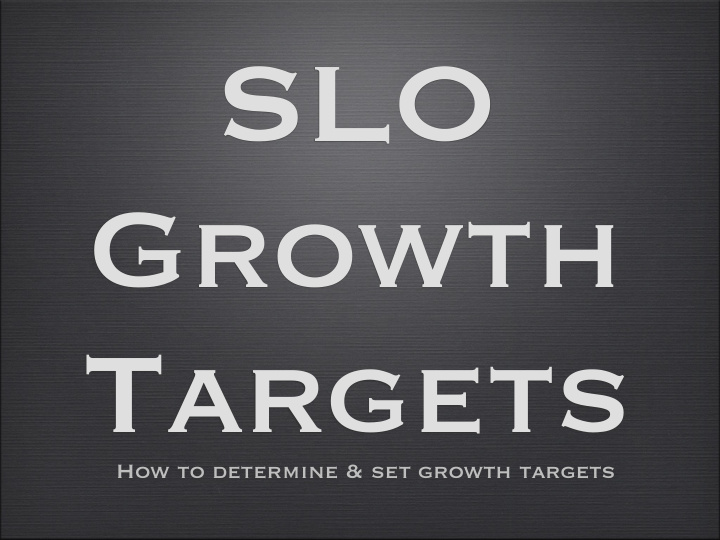



SLO Growth Targets How to determine & set growth targets
Today’s Learning Targets I CAN evaluate pre-assessment data & group my students by score ranges. I CAN set growth targets that are rigorous yet attainable. I CAN complete the Growth Target Template.
SLO Steps Gather & review available student data Determine interval of instruction & identify content Choose assessments & set growth targets Submit for approval Final scoring
SLO Growth Targets Informed Specific Tiered All Rigorous Attainable
Baseline & Trend Data Identify & summarize student info Review & draw upon trend data if appropriate or necessary Identify student strengths & weaknesses Sort data and identify ‘tiers’
Steps to Setting Growth Targets 1. Determine baseline data
Data Entry
Steps to Setting Growth Targets 1. Determine baseline data 2. Sort data & determine ‘tiers’
Re-sorted Notice that the data has been resorted by score. Ranges have been highlighted & color coded. These are TEACHER DETERMINED ranges.
Steps to Setting Growth Targets 1. Determine baseline data 2. Sort data & determine ‘tiers’ 3. Determine growth expectations
Rationale for Targets Why is the goal important? How is it achievable? Uses baseline data & standards Aligned to school & district goals
Steps to Setting 1. Determine baseline data 2. Sort data & determine ‘tiers’ 3. Determine growth expectations 4. Finalize targets
Example Growth Target #1 During the fall semester, all of my students will progress at least one fitness zone on the Fitness Gram.
Example Growth Target #2 Students will increase their scores by half the difference between 100 and their pre-assessment score. For example, a student with a pre-assessment score of 50 would be expected to increase his or her score by 25 points on the post-assessment. 100 - 50 = 50 / 2 = 25
Example Growth Target #3 Taking into account each student’s entry level of skill, all students will meet their target score on the post-assessment. Pre-Assessment Score Target Score 41-60 70 61-80 85 81-90 95 plus 85 or higher on project 91-100 95 plus 90 or higher on project
Example Growth Target #4 Taking into account each student’s entry level of skill, all students will meet their target score on the post-assessment. Pre-Assessment Target Score Score 41-60 70 or increase by 15, whichever is greater 61-80 85 or increase by 15, whichever is greater 95 or increase score by 7, whichever is 81-90 greater; plus 85 or higher on project 91-100 97 plus 90 or higher on project
Example Growth Target #5 Descriptive Target Students will improve their performance by meeting the following growth targets using LiguaFolio Can-Do Assessments, supporting data, and a final individualized performance assessment as sources of evidence. Baseline Data (from Sp. 1) Growth Target (Sp. 2) Novice Mid Novice High Novice High Intermediate Low Intermediate Low Intermediate Mid
Example Growth Target #6 BAD During the fall semester, 50% of my students will earn a National Physical Fitness award for their performance on the Physical Fitness Test.
Target #6: Rationale During the fall semester, 50% of my students will earn a National Physical Fitness award for their performance on the Physical Fitness Test. This target is focused on proficiency, not growth. It also only requires 50% of students to meet the goal. Revisions: • Use baseline data to inform target • Focus on GROWTH • Consider using a different assessment
Example Growth Target #7 BAD Students scoring 80 or lower on the pre-assessment will increase their scores on the similar post- assessment by at least 10 points. Any students scoring 81 or higher on the pre-assessment will maintain their scores.
Target #7: Rationale Students scoring 80 or lower on the pre-assessment will increase their scores on the similar post-assessment by at least 10 points. Any students scoring 81 or higher on the pre-assessment will maintain their scores. This target does not require ALL students to show growth. Revisions: • Revise to require very low-performing students to move toward proficiency. • Revise targets for students scoring 81 or higher so they must demonstrate growth.
Example Growth Target #8 BAD Taking into account each student’s entry level of skill, all students will meet their target score on the post-assessment. Pre-Assessment Score Target Score 41-60 65-74 61-80 75-90 81-90 91-100 91-100 95 plus 85 or higher on project
Target #8: Rationale Taking into account each student’s entry level of skill, all students will meet their target score on the post-assessment. Pre-Assessment Score Target Score 41-60 65-74 61-80 75-90 81-90 91-100 91-100 95 plus 85 or higher on project The use of ranges does not require ALL students to demonstrate growth Revisions: • Use minimum expectations (cut scores &/or expected improvement in points) rather than ranges
Spreadsheet Example
Appropriate Targets should... • Use baseline data... • Focus on GROWTH... • Allow for ALL students to show growth... • Use ranges for baseline & cut scores for targets...
Upcoming Sessions... SLO Submission • work session • get feedback before submission
Recommend
More recommend